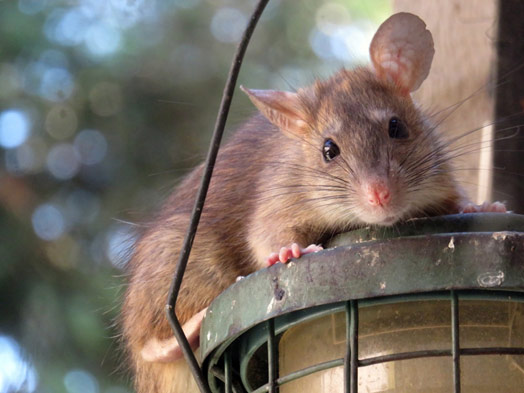What Are Roof Rats?
Roof rats typically weigh 5 to 10 ounces. They have light black to grey smooth fur on their bodies with off white to grey underbellies. They are usually about 15 inches long, and have a long hairless tail that can be about 14-1/2 inches long. Unlike Norway rats, their tails are longer than their heads and bodies combined. They have large ears and eyes (typically larger than those of the Norway rat) and have a pointed nose.
As their name indicates, roof rats usually nest high above ground in trees, tall overgrown shrubs, or dense vegetation such as ivy. Roof rats are excellent climbers and often access homes by running along tree branches, cables or wires. In buildings, they typically nest in the upper part of structures in enclosed or elevated spaces such as attics, walls, false ceilings, and cabinets. They are very agile and can squeeze through openings only 1/2-inch wide. Roof rats can climb down to a food source.
Roof rats routinely travel up to 300 feet for food. They often can be seen at night running along overhead utility lines or fence tops. They have an excellent sense of balance and use their long tails to steady themselves while traveling along overhead utility lines. They move faster than Norway rats and are very agile climbers, which enables them to quickly escape predators.
Given their history of causing damage (gnawing through wiring, food contamination, etc.) and health problems (vectors for salmonella, murine typhus, etc.), it is important that homeowners understand how to identify and businesses protect themselves from these costly pests.
Appearance
- About 15 inches long
- 5-10 oz.
- Appear sleek and graceful with a gray to black smooth coat.
- Large ears/eyes, pointed snout
- Long, hairless tail (about length of body)
Habitat/Harborage
Specializes in climbing
Can enter structures through trees, power lines. Dwells in areas off the ground like attics, wall voids, hollow trees, vine-covered fences
Feeding Habits
- Has a preference for the sweetness of fruit
- However, will feed on anything, including pet food
- Needs water everyday
Protection
- Seal openings greater than ¼” to exclude mice and ½” to exclude rats
- Use hardware cloth to seal open vents, especially in crawl spaces, attics, and roofs
- Eliminate waste piles outside of home
- Make sure garbage containers are sealed tightly
- Eliminate potential food sources like left over pet food and grains from bird feeders
- Trim vegetation to prevent from becoming overly dense.
Roof Rat Infestation
As climbers, roof rats are more likely to cause structural damage in homes as they chew on wood and wires. Like Norway rats, roof rats eat a wide variety of foods, but they prefer fruits, nuts, berries, slugs, and snails. Roof rats are especially fond of avocados and citrus, and they often eat fruit that is still on the tree. If roof rats are living in the attic of a residence, they can cause considerable damage with their gnawing and nest-building activities. Roof rats prefer to nest in locations off the ground and rarely dig burrows for living quarters if off-the-ground sites exist.
If roof rats are seen exposed, it often indicates that their hiding spaces are all filled by other rats or that they have been disturbed, such as by construction. Droppings are another good indicator of roof rat activity. Roof rat droppings are 4-1/2 to 5 inches with pointed ends (whereas Norway rat droppings are 7 to 7-1/2 inches) and capsule shaped. Other indicators can include grease marks which are produced as the rodent travels along an edge, and the oils in their fur are deposited. Indoor nests usually are constructed in insulation such as in attics.


